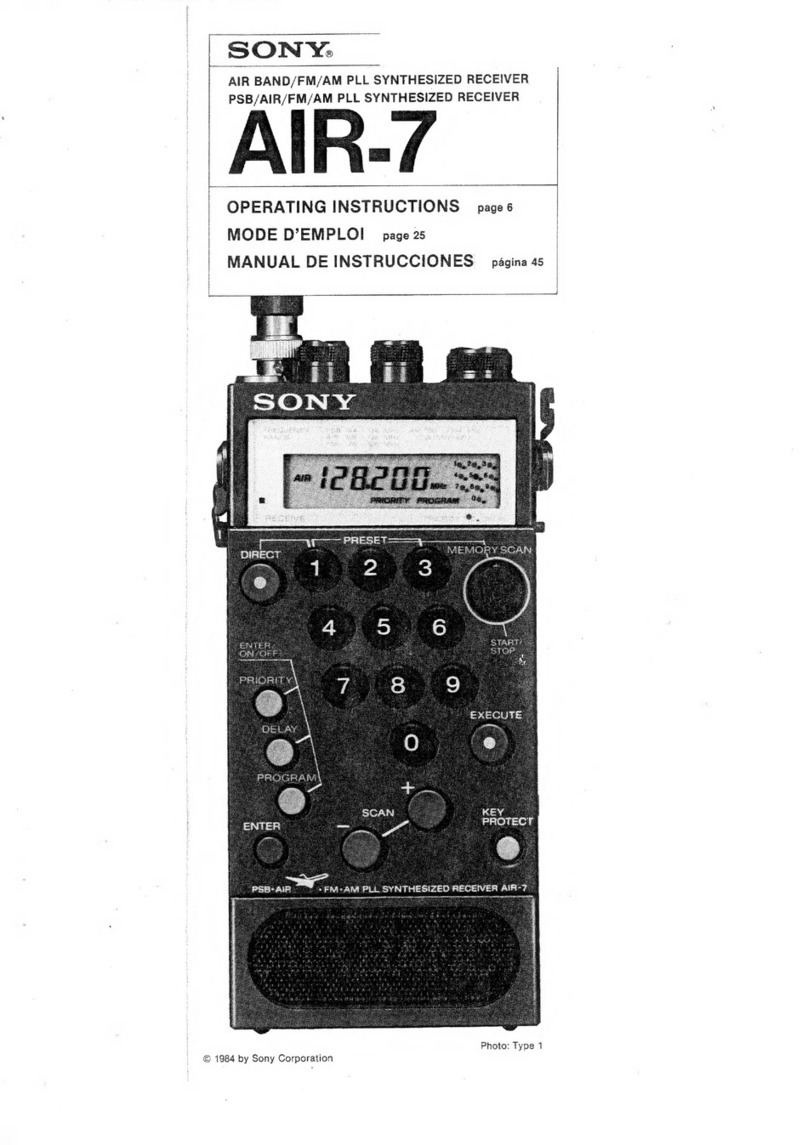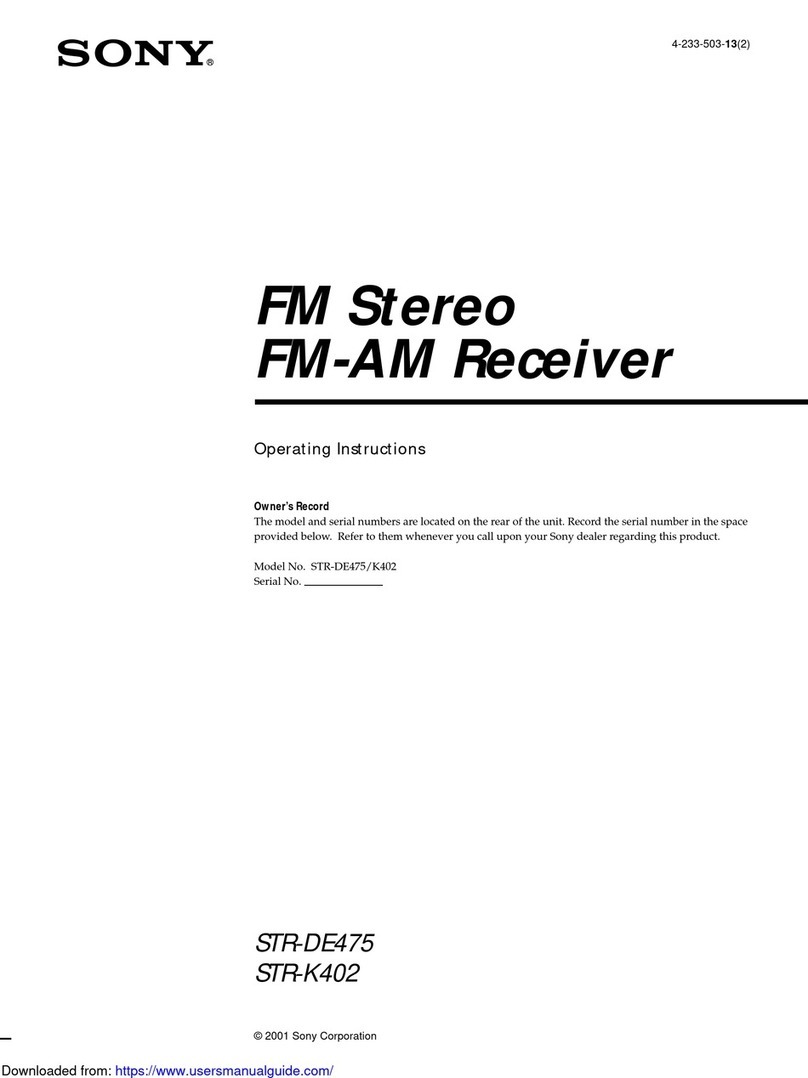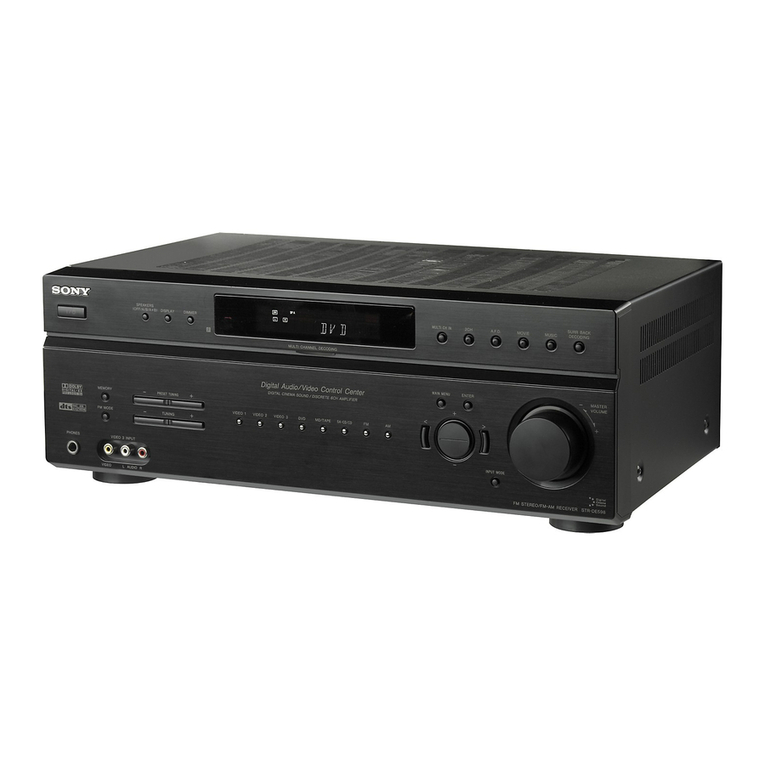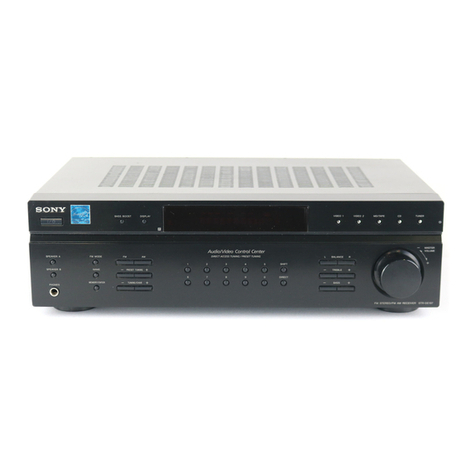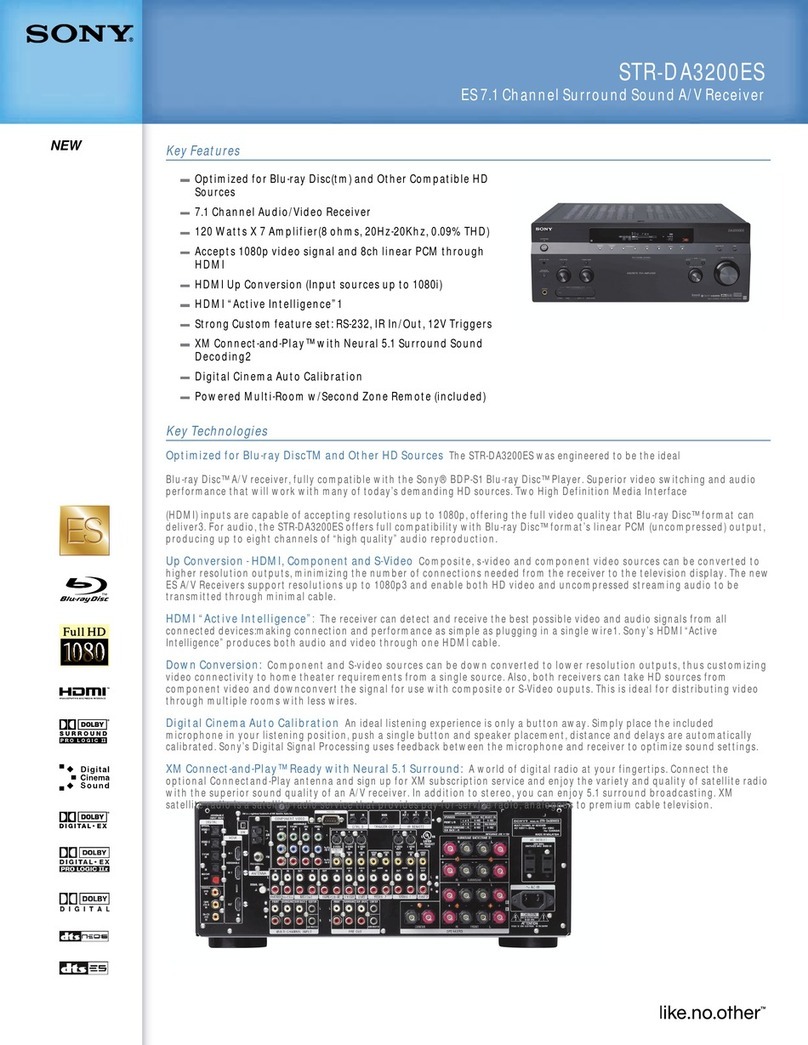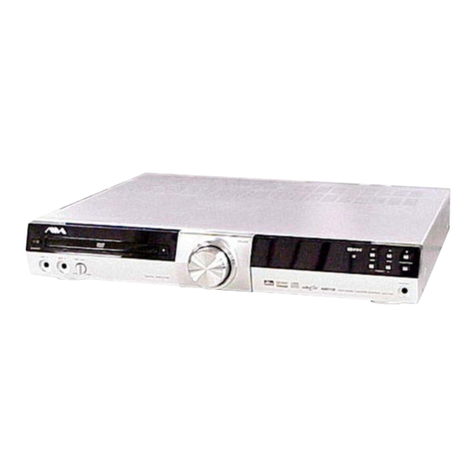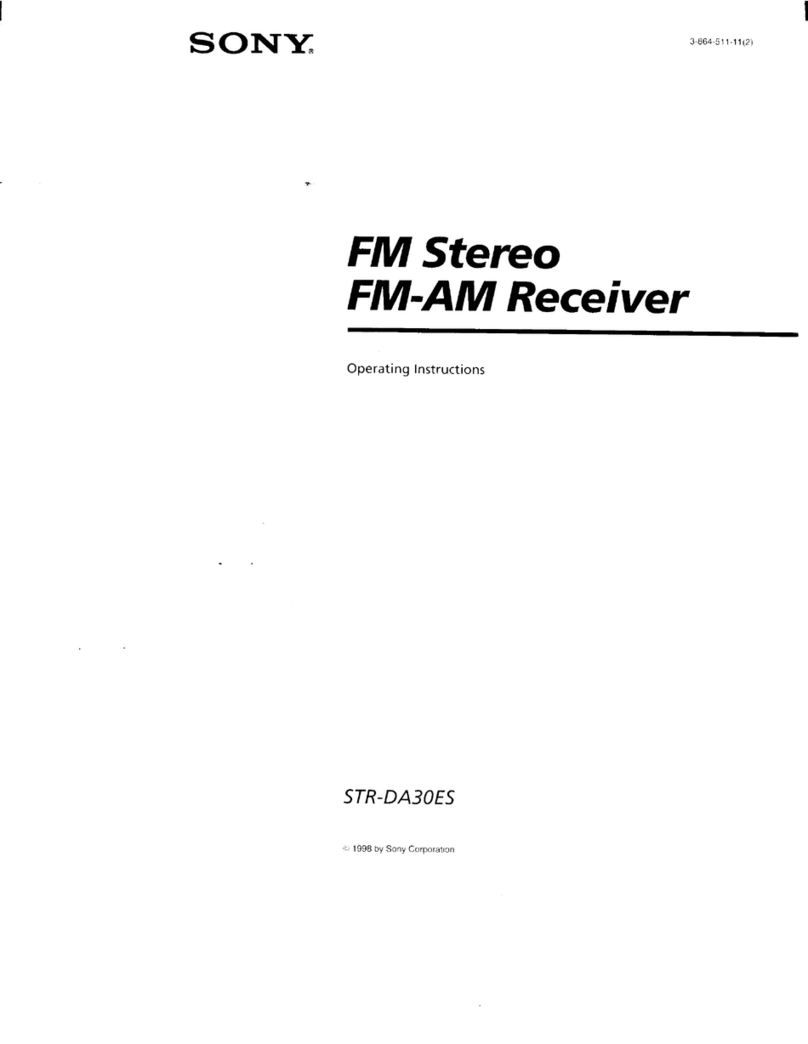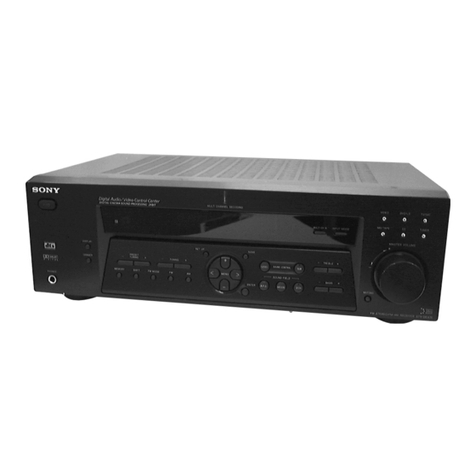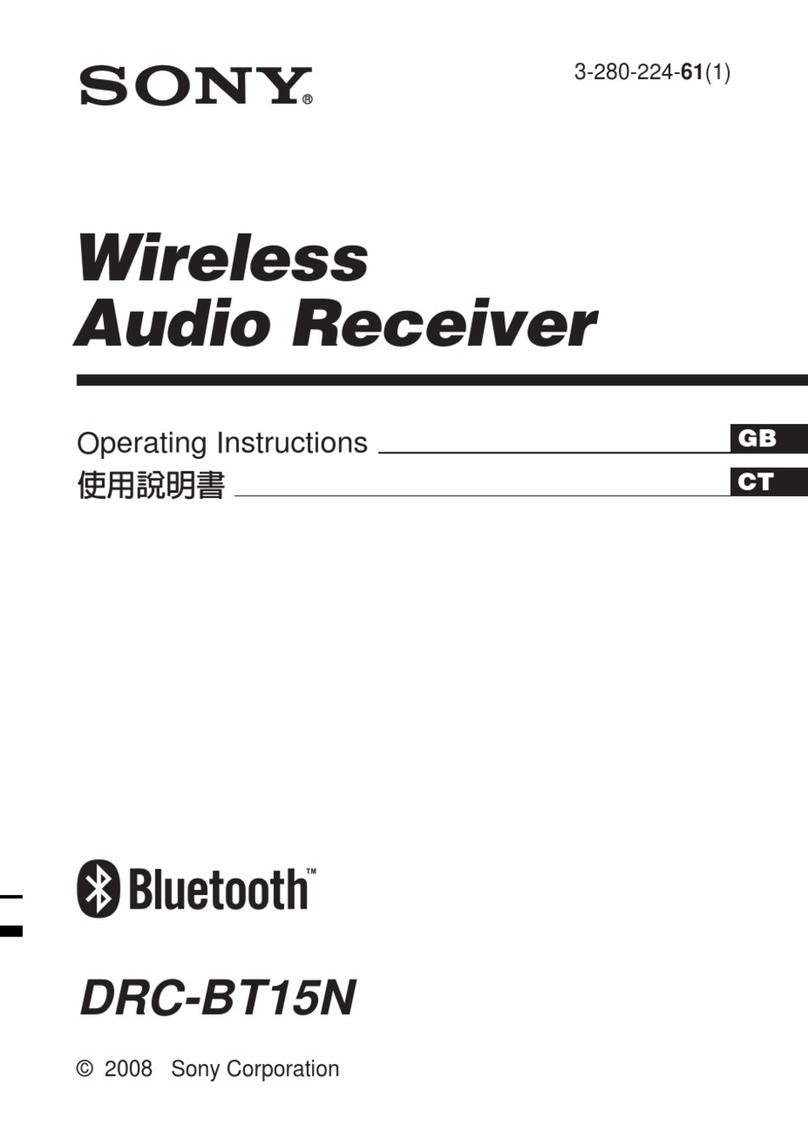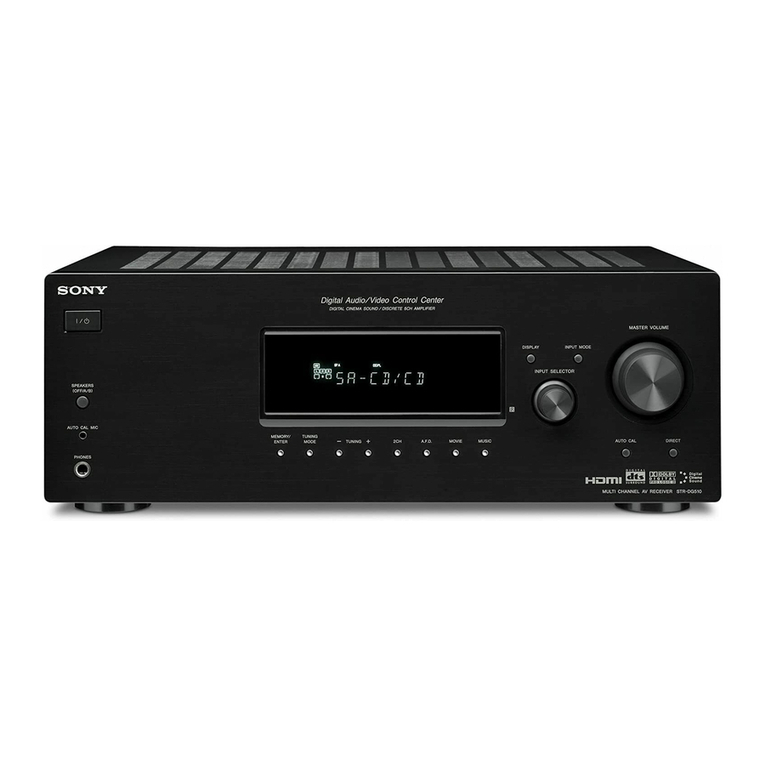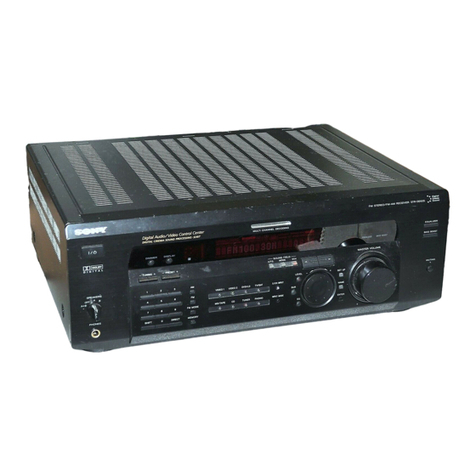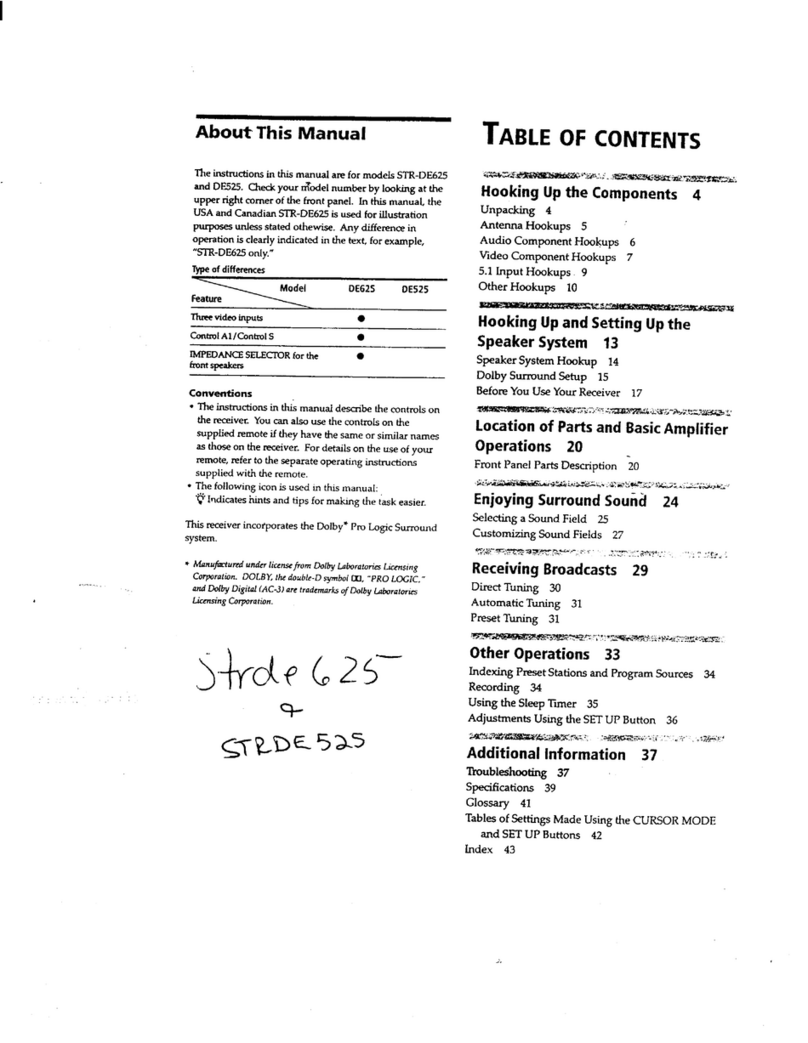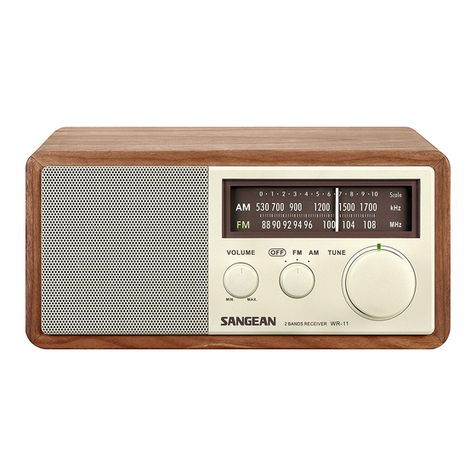
STR-DA3600ES 4-184-701-11(1) GB/FR
English
Calibrating the appropriate speaker settings
automatically (Auto Calibration)
You can set up the speakers to obtain the desired sound from all
connected speakers automatically by using the auto calibration
function.
Before you perform the auto calibration
During the calibration, the sound that comes out of the speakers is very
loud. Pay attention to the presence of children or to the effect on your
neighborhood.
Perform the measurement in a quiet environment to avoid the effect of noise
and get a more accurate measurement.
If there are any obstacles in the path between the optimizer microphone and
the speakers, the calibration cannot be performed correctly. Remove any
obstacle from the measurement area to avoid measurement error.
1Install and connect the speakers and TV.
For detail, see front page.
2Select the speaker pattern.
If you connect front high speakers, select the speaker pattern
that has front high speakers (5/.or 4/.) each time you
perform auto calibration. Otherwise, the characteristics of the
front high speakers cannot be measured.
3Connect the supplied optimizer microphone to
the AUTO CAL MIC jack.
The AUTO CAL MIC jack is used for the supplied optimizer
microphone only. Do not connect other microphones. Doing
so may damage the receiver and the microphone.
4Set up the optimizer microphone.
Place the optimizer microphone at your seating position. Use
a stool or tripod so that the optimizer microphone remains at
the same height as your ears.
On setting up the active subwoofer
When a subwoofer is connected, turn on the subwoofer and turn
up the volume beforehand. Turn the MASTER VOLUME knob
to just before the mid-point.
If you connect a subwoofer with the crossover frequency
function, set the value to maximum.
If you connect a subwoofer with an auto standby function, set it
to off (deactivated).
Performing auto calibration
The auto calibration function allows you to measure the following:
speaker connections, polarity of speakers, speaker distance,
speaker size, speaker level, frequency characteristics.
1Connect a TV monitor to this receiver.
Refer to “2: Connecting the monitor” in the operating
instructions.
2Turn on the receiver and the TV.
Switch the input of the TV so that an image of the menu is
displayed.
3Press MENU.
The menu is displayed on the TV screen.
4Press /repeatedly to select “ Settings,” then
press or .
The Settings menu list appears on the TV screen.
5Press /repeatedly to select “Auto Calibration,”
then press .
6Press /repeatedly to select “Calibration Start,”
then press .
The screen on which you can select the item to be measurered
appears.
7Press /repeatedly and to un-check the items
you do not want to measure, then press .
The confirmation screen, asking whether you are ready to
start measurement, appears.
8Press to select “Start.”
The measurement starts in five seconds.
The measurement process will take approximately 30
seconds with a test tone. Wait until the measurement process
completes.
When the measurement ends, a beep sounds and the screen
switches.
9Press /repeatedly to select “Save,” then press
.
The selecting screen of the calibration type appears.
10 Press /repeatedly to select the calibration
type, then press .
Parameter Explanation
Full Flat Makes the measurement of frequency from
each speaker flat.
Engineer Sets the frequency to one that matches that
of the Sony listening room standard.
Front Reference Adjusts the characteristics of all the
speakers to match the characteristics of the
front speaker.
OFF Sets the auto calibration EQ to off.
The measurement results are saved.
11 Press RETURN/EXIT.
Checking the auto calibration results
Press /to select “Warning” in step 9, then press . If a
warning message appears, check the message and use the receiver
without change. Or if necessary, perform auto calibration again.
For details on warning and error codes, see “Message list after
auto calibration measurement” in “10: Calibrating the appropriate
speaker settings automatically (Auto Calibration)” in the operating
instructions.
Tip
The size of a speaker (Large/Small) is determined by the low characteristics.
The measurement results may vary, depending on the position of the optimizer
microphone and speakers, and the shape of the room. It is recommended that
you follow the measurement results. However, you can change those settings
in the Speaker settings menu. Save the measurement results first, then try to
change the settings if you want.
Setting up other components
You should set up each component so that take out sound is
output from speakers correctly when you play back a connected
component.
To output multi-channel digital audio, check the digital audio
output setting on the connected components.
For a Blu-ray Disc Player, check that “Audio (HDMI),” “Dolby
Digital (Coaxial/Optical),” and “DTS (Coaxial/Optical)” are set to
“Auto,” “Dolby Digital,” and “DTS,” respectively (as of March 2010).
For a PlayStation 3, check that “BD Audio Output Format” is set to
“Bitstream” (with system software version 3.15).
For details, refer to the operating instructions supplied with the
connected components.
The following case describes Sony components.
Sony Super Audio CD player
Select a suitable playback area (multi-channel or 2 channel).
Sound may come out from only the front speaker left/right when 2
channel is selected.
After the setting
The receiver is now ready to use. Refer to the operating instruction
supplied with the receiver for details.
Français
Calibrage automatique aux réglages
appropriés (Auto Calibration)
Vous pouvez régler les enceintes pour obtenir automatiquement
le son souhaité depuis toutes les enceintes raccordées à l’aide de la
fonction de calibrage automatique.
Avant de commencer le calibrage
automatique
Pendant le calibrage, le son émis par les enceintes est très fort. Veillez à ce qu’il
n’y ait pas d’enfants à proximité et à ne pas perturber le voisinage.
Effectuez la mesure dans un environnement silencieux pour éviter l’effet de
bruit et obtenir une mesure plus précise.
S’il y a des obstacles dans la trajectoire entre le microphone d’optimisation
et les enceintes, le calibrage ne s’effectuera pas correctement. Pour éviter des
erreurs de mesure, enlevez tout obstacle de la zone de mesure.
1Installez et raccordez les enceintes et le téléviseur.
Pour plus d’informations, voir la couverture.
2Sélection de la configuration des enceintes.
Si vous raccordez des enceintes avant supérieures,
sélectionnez la configuration des enceintes qui tient compte
des enceintes avant supérieures (5/.ou 4/.) à chaque
fois que vous effectuez un calibrage automatique. Sinon, il
n’est pas possible de mesurer les caractéristiques des enceintes
avant supérieures.
3Raccordez le microphone d’optimisation fourni à
la prise AUTO CAL MIC.
La prise AUTO CAL MIC ne doit être utilisée que pour le
microphone d’optimisation fourni. Ne raccordez pas un autre
microphone. Ceci pourrait endommager l’ampli-tuner et le
microphone.
4Installez le microphone d’optimisation.
Placez le microphone d’optimisation à votre postion d’écoute.
Utilisez un tabouret ou un trépied pour que le microphone
d’optimisation soit à la même hauteur que vos oreilles.
Réglage du subwoofer amplifié
Si un subwoofer est raccordé, allumez-le et augmentez le volume
au préalable. Tournez le bouton MASTER VOLUME jusqu’un
peu avant le point central.
Si le subwoofer est doté d’une fonction de sélection de la
fréquence de recouvrement, choisissez la valeur maximale.
Si le subwoofer est doté d’une fonction de mise en veille
automatique, désactivez cette fonction.
Exécution du calibrage automatique
La fonction de calibrage automatique vous permet de déterminer
ce qui suit : la connexion, la polarité, la distance, la taille, le niveau
des enceintes, les caractéristiques de la fréquence.
1Raccordez un écran de téléviseur à cet ampli-
tuner.
Consultez « 2 : Raccordement de l’écran » dans le mode
d’emploi.
2Allumez l’ampli-tuner et le téléviseur.
Sélectionnez la source d’entrée du téléviseur de façon que
l’image du menu soit affichée.
3Appuyez sur MENU.
Le menu s’affiche sur l’écran du téléviseur.
4Appuyez plusieurs fois sur /pour sélectionner
« Settings », puis appuyez sur ou .
La liste du menu Settings s’affiche sur l’écran du téléviseur.
5Appuyez plusieurs fois sur /pour sélectionner
« Auto Calibration », puis appuyez sur .
6Appuyez plusieurs fois sur /pour sélectionner
« Calibration Start », puis appuyez sur .
L’écran sur lequel vous pouvez sélectionner l’option à mesurer
apparaît.
7Appuyez plusieurs fois sur /et sur pour
décocher les options que vous ne voulez pas
mesurer, puis appuyez sur .
L’écran de confirmation, vous demandant si vous êtes prêt à
commencer la mesure, apparaît.
8Appuyez sur pour sélectionner « Start ».
La mesure commence dans les cinq secondes.
Le processus de mesure prendra environ 30 secondes avec
un signal de test. Attendez que le processus de mesure soit
terminé.
Lorsque la mesure se termine, un bip retentit et l’écran
s’affiche.
9Appuyez plusieurs fois sur /pour sélectionner
« Save », puis appuyez sur .
L’écran de sélection du type de calibrage s’affiche.
10 Appuyez plusieurs fois sur / pour sélectionner
le type de calibrage, puis appuyez sur .
Paramètre Explication
Full Flat Rend la mesure de fréquence de chaque
enceinte plane.
Engineer Sélectionne des caractéristiques de
fréquence correspondant aux normes d’un
auditorium Sony.
Front Reference Règle les caractéristiques de toutes les
enceintes sur celles des enceintes avant.
OFF Désactive l’EQ de calibrage automatique.
Les résultats de mesure sont sauvegardés.
11 Appuyez sur RETURN/EXIT.
Vérifier les résultats du calibrage automatique
Appuyez sur /pour sélectionner « Warning » à l’étape 9, puis
appuyez sur . Si un message d’avertissement apparaît, vérifiez le
message et utilisez l’ampli-tuner sans modification. Si nécessaire,
effectuez un calibrage automatique une nouvelle fois.
Pour plus de détails sur les codes d’avertissement et d’erreur, voir
« Liste des messages après une mesure de calibrage automatique »
de « 10 : Calibrage automatique aux réglages appropriés (Auto
Calibration) » dans le mode d’emploi.
Conseil
La taille d’une enceinte (Large/Small) est déterminée par les caractéristiques
basses. Les résultats de mesure peuvent différer selon la position du microphone
d’optimisation et des enceintes et en fonction de la forme de la pièce. Il est
recommandé de suivre les résultats de mesure. Vous pouvez toutefois changer
ces paramètres dans le menu de paramétrage des enceintes. Sauvegardez les
résultats de mesure avant de changer éventuellement les réglages.
Paramétrage d’autres appareils
Vous devez paramétrer chaque appareil de sorte que le son soit
sorti correctement des enceintes lorsque vous utilisez un appareil
raccordé.
Pour l’émission du son numérique multicanal, vérifiez le réglage de
la sortie audio numérique sur les appareils raccordés.
Pour un lecteur Blu-ray Disc, vérifiez que « Audio (HDMI) »,
« Dolby Digital (Coaxial/Optical) » et « DTS (Coaxial/Optical) »
sont réglés respectivement sur « Auto », « Dolby Digital » et
« DTS » (à partir de mars 2010).
Pour une PlayStation 3, vérifiez que « BD Audio Output Format »
est réglé sur « Bitstream » (avec la version du logiciel du système
3.15).
Pour plus de détails, consultez le mode d’emploi livré avec les
appareils raccordés.
Le cas suivant décrit des appareils Sony.
Lecteur Super Audio CD Sony
Sélectionnez une plage de lecture adéquate (multicanaux ou 2
canaux). Il est possible que le son ne sorte que de l’enceinte avant
gauche/droit lorsque 2 canaux est sélectionné.
Après le paramétrage
L’ampli-tuner est maintenant prêt à l’usage. Reportez-vous au mode
d’emploi fourni avec l’ampli-tuner pour plus d’informations.
AUTO CAL MIC
3
4-10
11
3MENU
4/ , /
5/ ,
6/ ,
7/ , ,
8
9/ ,


